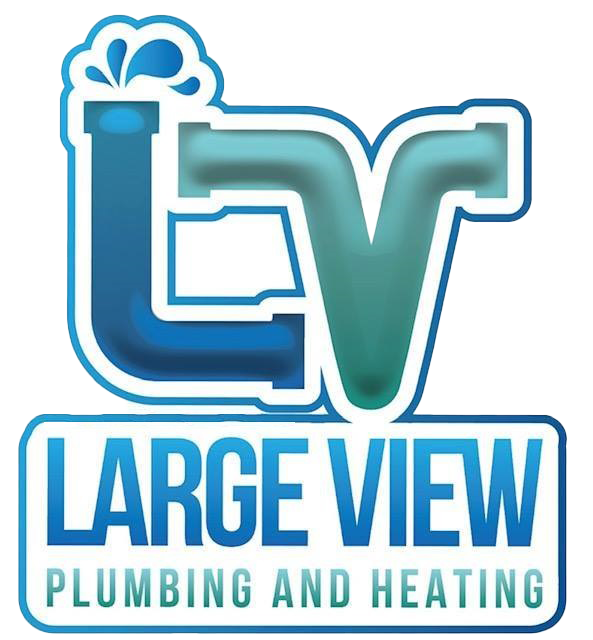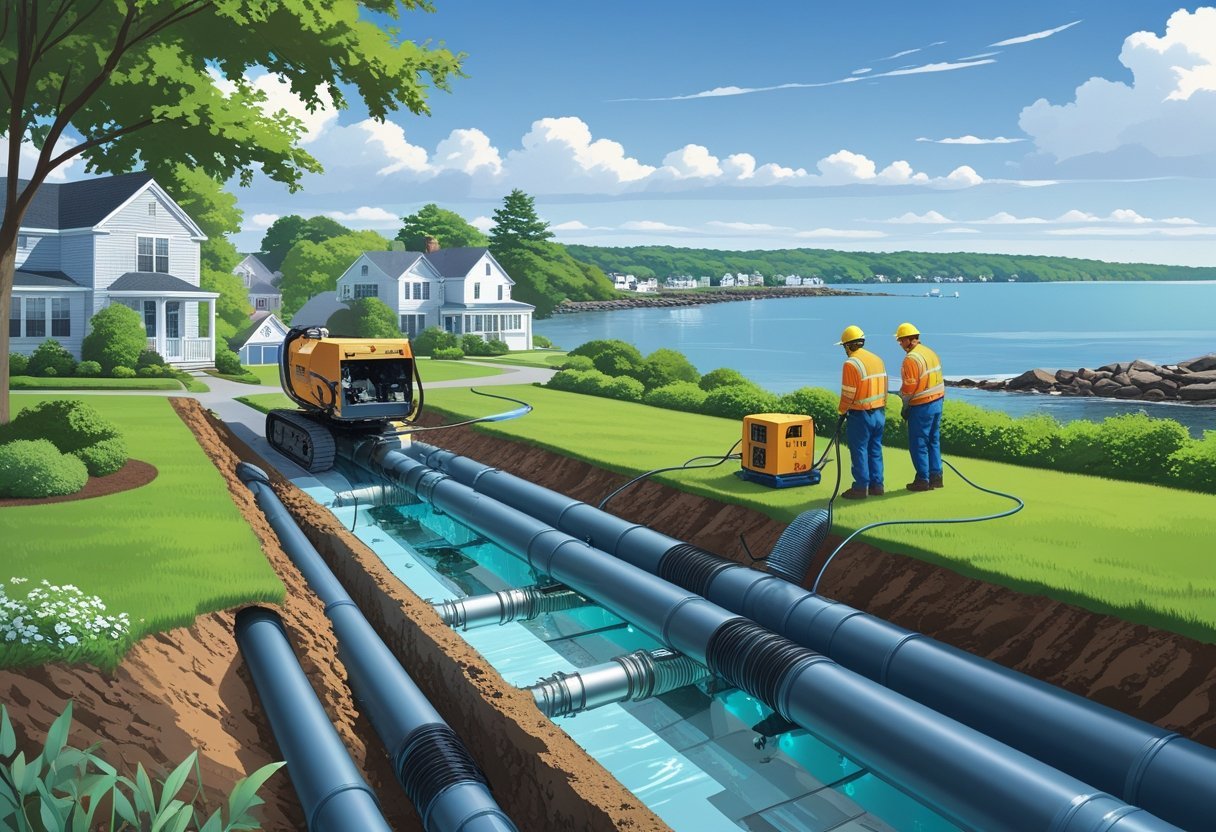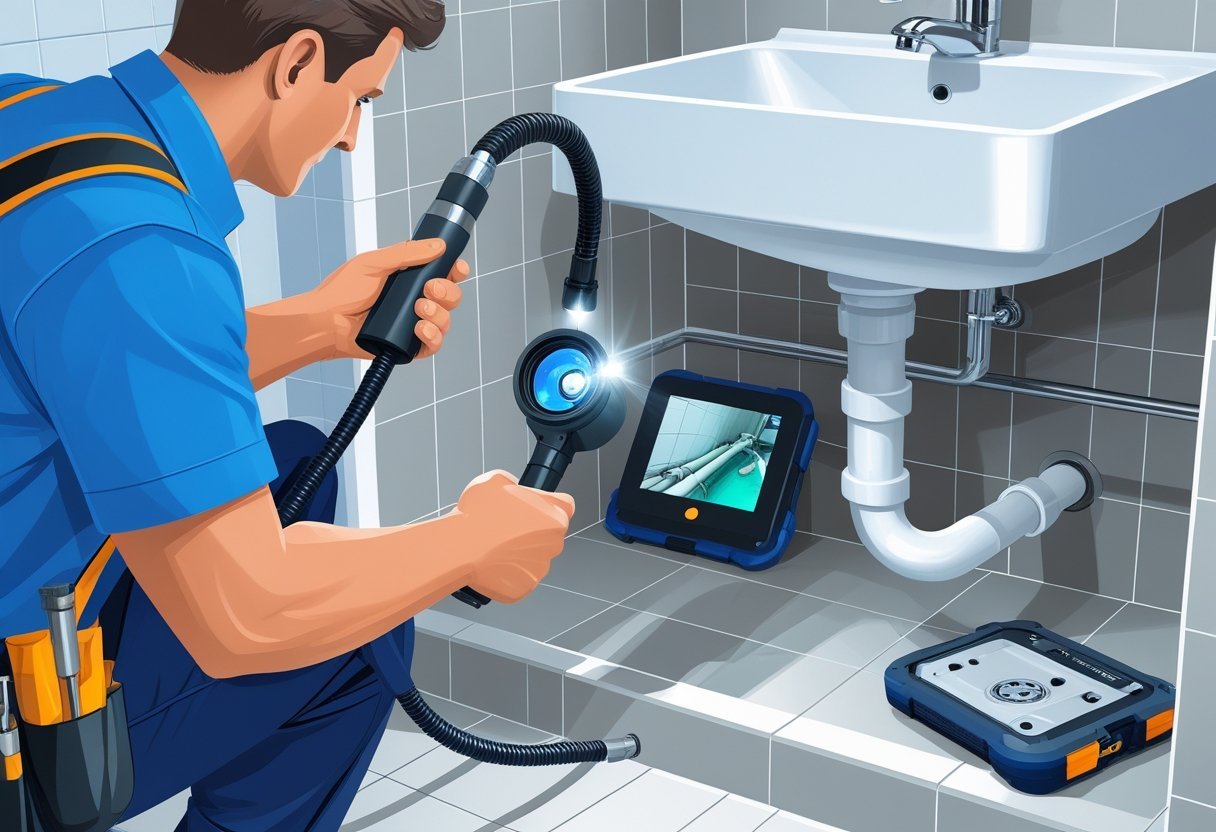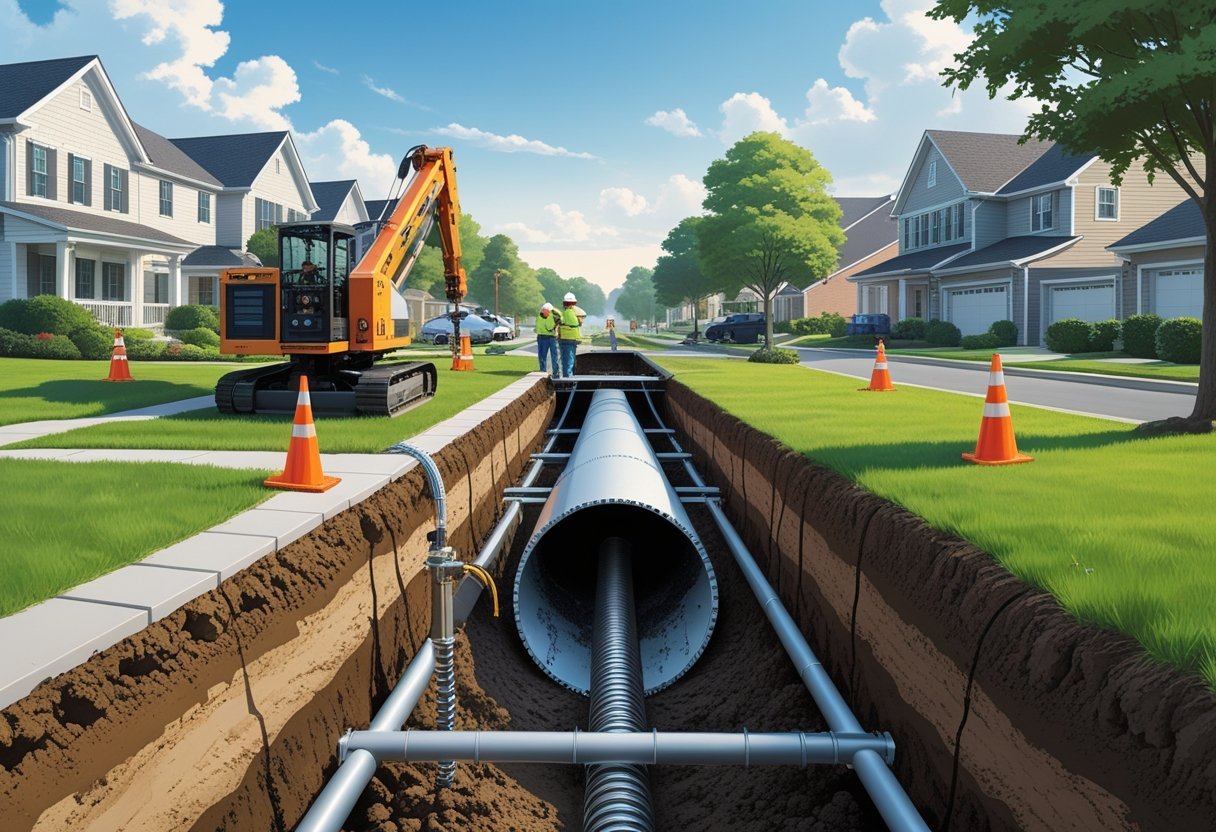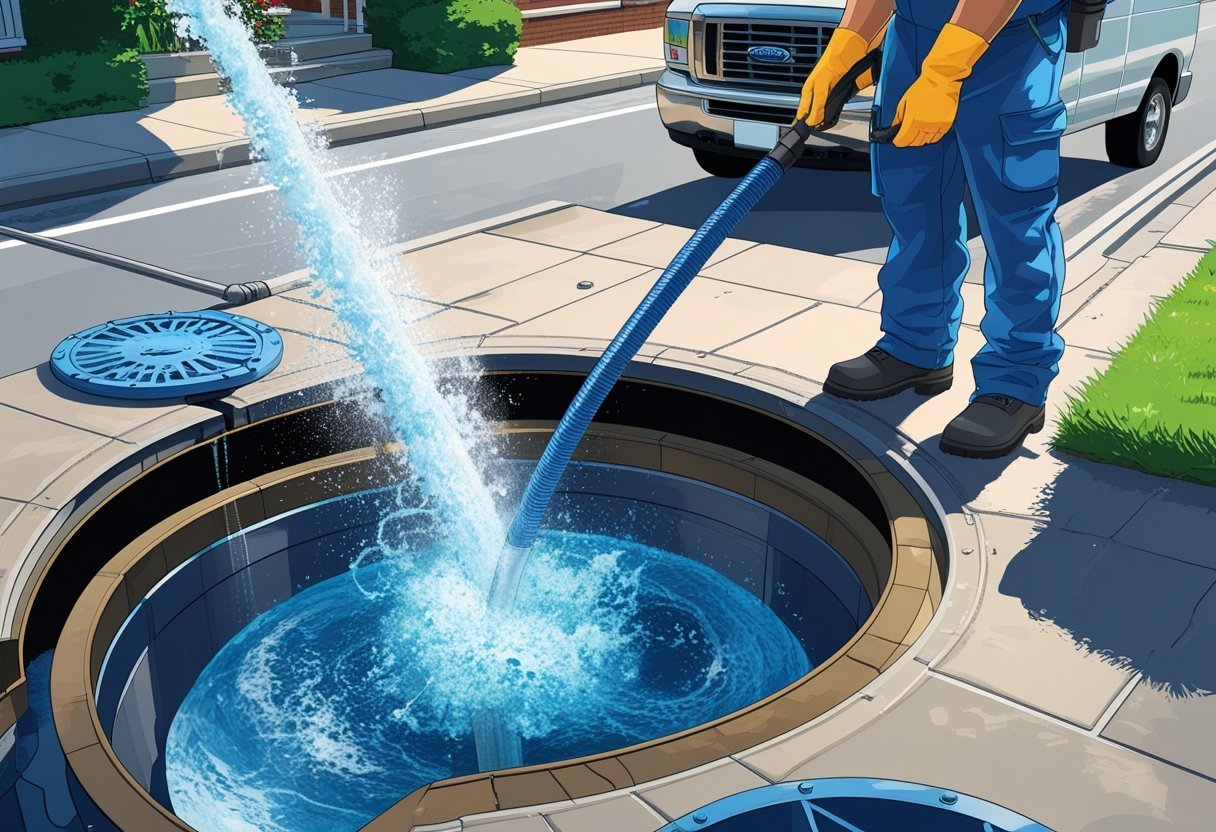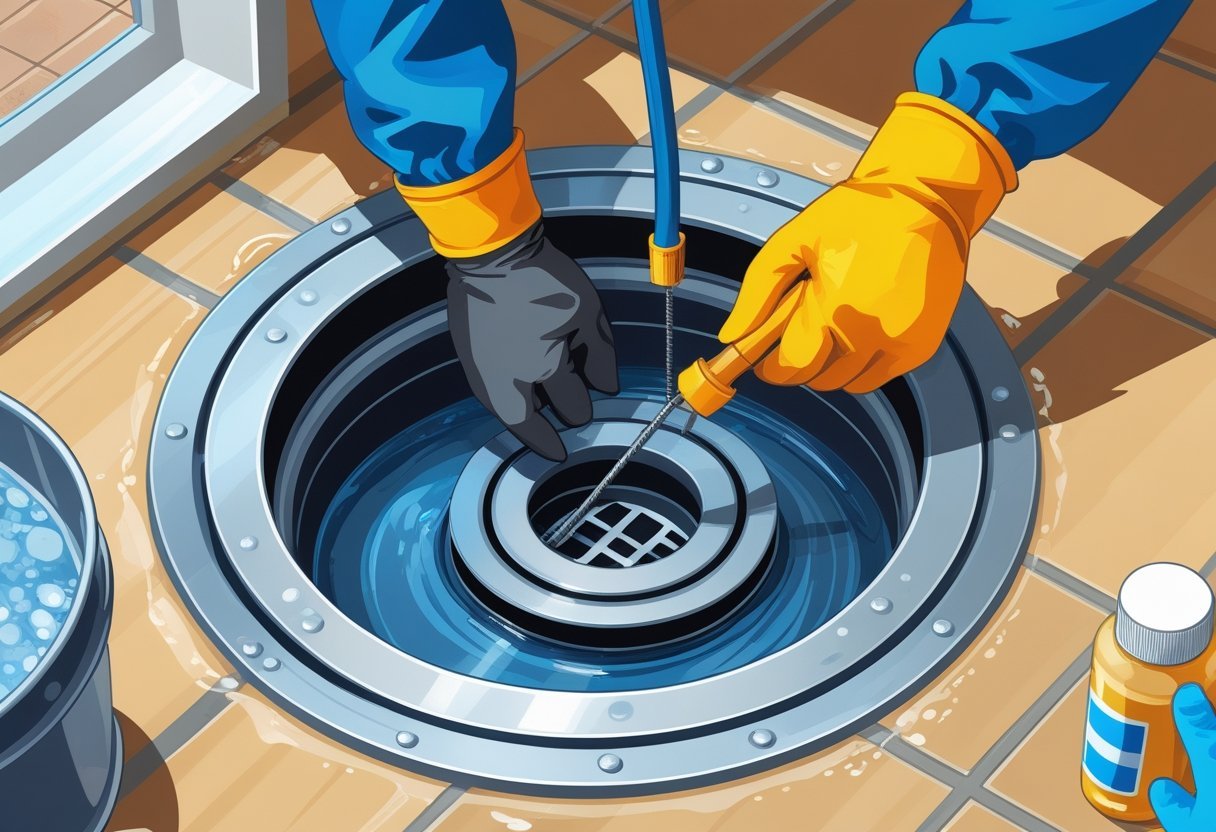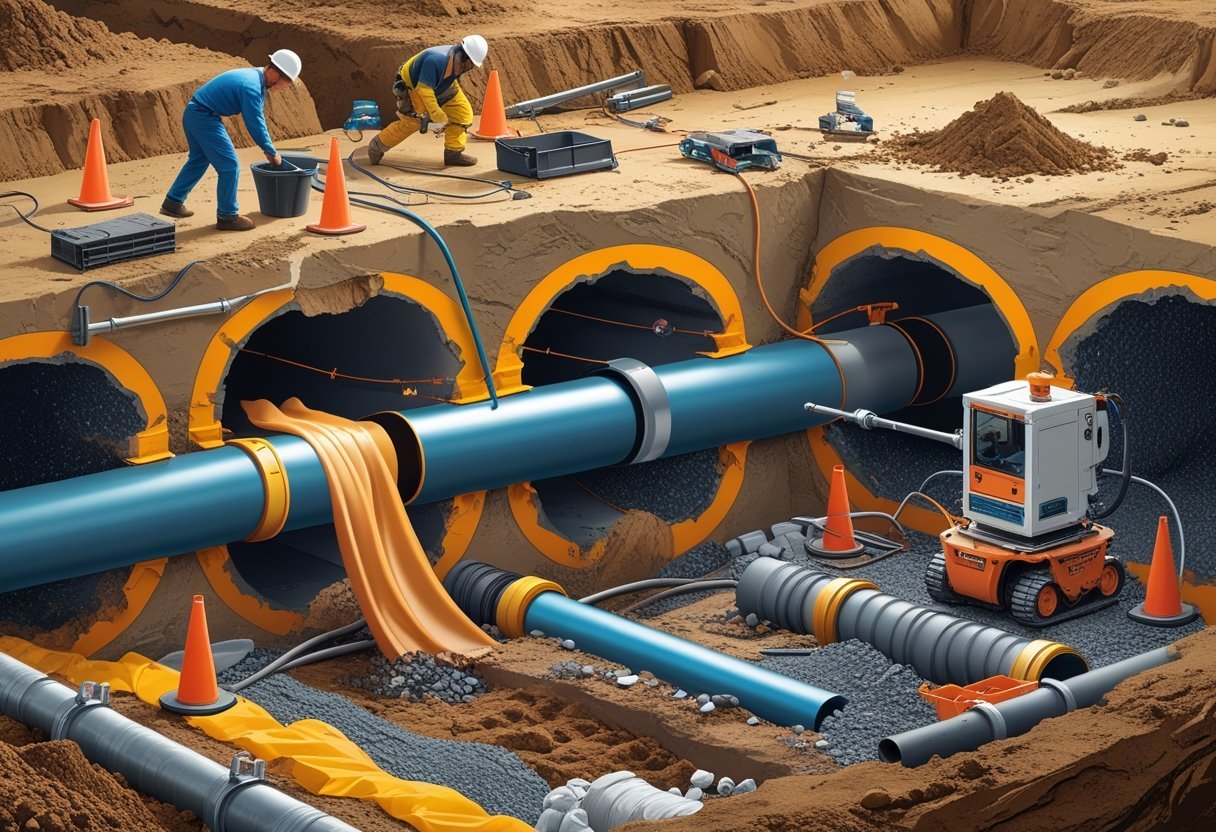Trenchless pipe replacement is a method of fixing or replacing underground pipes without digging large open trenches. This technique allows you to repair damaged water, sewer, or gas lines with minimal disruption to your yard, driveway, or landscaping. Instead of removing concrete or digging deep trenches, trenchless solutions use modern technology to access and rehabilitate pipes quickly and efficiently.
If you’re facing pipe issues, understanding trenchless pipe replacement can save you time, money, and the hassle of extensive excavation. Large View Plumbing & Heating offers expert trenchless services in North Shore, Massachusetts, combining over 10 years of experience with advanced tools to ensure your plumbing is restored with minimal impact to your property. With their skilled team, you can expect reliable and customer-focused solutions tailored to your needs.
What Is Trenchless Pipe Replacement
Trenchless pipe replacement lets you fix or replace underground pipes without extensive digging. It reduces surface disruption and speeds up pipe repairs or replacements, particularly in sewer systems and water lines. The method uses specialized equipment that minimizes damage to your property.
Definition and Core Principles
Trenchless pipe replacement is a method for repairing or replacing underground pipes without large trenches. Instead of digging up your yard or driveway, it relies on remote tools inserted through small access points.
Two main techniques are used:
- Pipe Lining: Inserting a resin-coated liner that hardens inside the existing pipe to create a new, seamless pipe.
- Pipe Bursting: Breaking the old pipe while simultaneously pulling a new pipe into place.
The goal is to restore or replace damaged pipes while preserving landscaping, sidewalks, and driveways. It’s a less invasive way to address sewer systems, water supply lines, gas lines, and storm drains.
How Trenchless Differs from Traditional Methods
Traditional pipe replacement requires digging open trenches along the entire length of the pipe. This causes surface damage, longer repair times, and higher costs from restoration work.
Trenchless technology avoids this by:
- Creating entry and exit points only at the pipe ends or strategic spots.
- Using cameras for inspection, reducing guesswork and excavation.
- Minimizing disruption to your property, saving landscaping and hardscape features.
- Often reducing project time from days or weeks to just hours.
This approach results in less mess, lower overall labor, and fewer interruptions to your routine. It’s especially beneficial in residential areas where restoring yard or driveway damage from traditional digging can be costly.
Brief History of Trenchless Technology
Trenchless methods emerged in the late 20th century as an alternative to disruptive pipe repair. Initially developed for sewer system rehabilitation, the technology evolved with advances in materials and remote inspection tools.
The use of cured-in-place pipe lining (CIPP) in the 1970s marked a significant breakthrough. The 1980s and 90s saw improvements in pipe bursting and horizontal directional drilling, expanding trenchless applications to water lines and gas pipes.
Today, companies like Large View Plumbing & Heating utilize these modern trenchless solutions to provide durable, efficient repairs with minimal disruption to homeowners. This technology reflects a shift toward faster, cleaner, and more cost-effective underground pipe work.
Common Trenchless Pipe Replacement Methods
Trenchless pipe replacement uses specialized techniques that avoid extensive digging. These methods minimize disruption to your property while efficiently addressing damaged or aged underground pipes. Understanding the distinctions between the different processes helps you choose the right option for your needs.
Pipe Bursting Overview
Pipe bursting replaces old pipes by fracturing the existing pipe’s walls while simultaneously pulling in a new pipe behind it. The process begins with inserting a bursting head through an access point. This head breaks apart the old pipe as it moves forward.
The new pipe, often made from durable high-density polyethylene (HDPE), follows directly behind the bursting head, taking the place of the broken pipe. This method requires two access pits—one at each end of the pipe section—and works well for pipes that are severely damaged or collapsed.
Pipe bursting is effective because it restores full pipeline diameter without excavation, making it ideal for water line replacement or sewer repairs. If you value quick restoration with minimal yard disruption, this method is a strong choice.
Cured-In-Place Pipe Lining (CIPP)
Cured-In-Place Pipe Lining, or CIPP, rehabilitates pipes by inserting a resin-saturated liner into the existing pipe. The liner is inflated and then cured using heat or UV light, forming a tight-fitting, seamless new pipe inside the old one.
This method does not remove the old pipe but reinforces it, which extends the lifespan of your plumbing without digging up your yard. CIPP is especially useful for pipes that have cracks or minor corrosion but still retain structural integrity.
The process requires minimal excavation, usually just access to cleanouts, making it convenient and cost-effective for sewer or drain line repair. The result is a smooth, corrosion-resistant interior that improves flow and prevents future leaks.
Structural Pipe Lining
Structural pipe lining is similar to CIPP but emphasizes restoring the pipe’s structural integrity. Instead of simply coating the old pipe, this method creates a rigid new pipe that can handle external soil pressure and avoid future collapses.
Typically, structural lining uses thicker resin materials or multiple resin layers for added strength. It is designed for older pipes with significant damage or deformation, where simple lining would be inadequate.
This method also requires access points but provides a durable replacement that can extend the service life of your drainage or sewer systems by decades without the need for traditional excavation.
For reliable trenchless repair or replacement services at your North Shore, Massachusetts property, Large View Plumbing & Heating uses these modern methods to ensure efficient, long-lasting results.
The Trenchless Pipe Replacement Process
Trenchless pipe replacement involves precise evaluation, limited site disturbance, and efficient installation techniques. It avoids extensive digging while ensuring pipes are fully assessed and replaced with minimal impact to your property.
Pipe Inspection and Camera Assessment
The process starts with a thorough pipe inspection using specialized sewer line cameras. These cameras provide clear visuals inside your pipes, identifying cracks, blockages, or deterioration without invasive digging. This step is crucial to determine the pipe’s condition and suitability for trenchless methods.
A certified plumber uses this inspection to locate problem areas and measure pipe diameter and alignment. The information gathered guides whether pipe bursting or pipe lining will be the best technique for your replacement.
At Large View Plumbing & Heating, we rely on high-quality camera technology to ensure an accurate diagnosis before proceeding. This prevents unnecessary disruption and targets repairs precisely where needed.
Site Preparation and Minimal Excavation
Unlike traditional replacement methods requiring large trenches, trenchless replacement needs only small access points. Usually, entry and exit pits are dug at strategic locations like the pipe’s start and end or an access cleanout.
These pits give plumbing professionals room to maneuver equipment without disturbing landscaping, driveways, or sidewalks. The minimal excavation reduces cleanup time and limits damage to your yard.
During preparation, your plumber will also clear the pipeline using hydro-jetting or pipe cleaning to remove debris for smooth equipment passage. Proper preparation is key to a successful installation.
Replacement and Installation Steps
There are two primary installation methods used in trenchless replacement: pipe bursting and pipe lining.
- Pipe bursting involves pulling a new pipe through the old one while breaking the original pipe apart. This expands the pipe path without excavation.
- Pipe lining inserts a resin-coated liner inside the damaged pipe, which hardens to form a durable new internal pipe.
Both methods restore pipe function without the mess of traditional digging. Equipment is inserted through the access pits, guided through the line, and then activated to complete the process.
Throughout replacement, plumbers from Large View Plumbing & Heating monitor progress closely for alignment and structural integrity. Final inspections ensure your water pipes or sewer lines are fully operational, meeting quality standards.
Applications and When to Use Trenchless Pipe Replacement
Trenchless pipe replacement is a practical solution when traditional digging is too disruptive or costly. It works especially well in situations that require minimal surface disturbance while addressing pipe issues effectively.
Typical Situations and Pipe Types
You should consider trenchless pipe replacement for underground pipes that have deteriorated due to age or damage. Common pipes suited for this method include sewer lines, water supply pipes, and stormwater drains.
This method is especially beneficial when your property has landscaping, sidewalks, or structures above the pipe. Instead of digging trenches that cause major disruption, trenchless techniques like pipe lining or pipe bursting let you replace or repair pipes with minimal excavation.
If your pipes are made of clay, cast iron, or older materials prone to cracking and leaking, trenchless replacement can extend their lifespan without the mess of traditional repairs. Large View Plumbing & Heating often recommends trenchless solutions when maintaining property integrity matters.
Addressing Sewage Backups and Emergency Scenarios
In cases of sewage backups, timely intervention is crucial to prevent health hazards and property damage. Trenchless pipe replacement allows quicker access to the problem area without prolonged disruption to your home or business.
You can avoid major excavation delays in emergencies. Trenchless techniques enable fast repair or replacement of blocked or broken sewer lines often found after sewer pipe inspection. You can restore proper flow with less downtime and lower risk of secondary damage to your yard or driveway.
Because trenchless methods reduce the need to dig, they also limit collateral damage usually associated with emergency pipe replacement, helping you recover faster.
Suitability for Sewer Line and Water Pipe Issues
Trenchless technology is ideal when dealing with problems in both sewer lines and water pipes. If your sewer line has roots intrusion, corrosion, or cracks detected during inspection, trenchless pipe lining or pipe bursting offers a durable fix without digging up your entire yard.
For water pipes, trenchless replacement works well when leaks or bursts occur below ground, especially where excavation would cause major disruption to your property or infrastructure. This method provides a cost-effective alternative by avoiding extensive digging and restoration costs.
When you need expert guidance on whether trenchless replacement fits your situation, Large View Plumbing & Heating serves North Shore, Massachusetts, providing detailed sewer line inspection and reliable solutions tailored to your needs.
Advantages and Limitations of Trenchless Pipe Replacement
Trenchless pipe replacement offers a modern approach to repairing or replacing damaged pipes without extensive digging. This method brings specific environmental and cost advantages, reduces disruption to your property, but also comes with certain practical limitations to consider.
Environmental and Cost Benefits
Trenchless pipe replacement, including trenchless sewer repair and HDPE pipe installation, minimizes excavation, reducing soil disruption and waste. Because it avoids large open trenches, it lowers the environmental impact, such as soil erosion and habitat disturbance.
Cost-saving benefits often come from reduced labor and shorter project times. While the upfront cost can sometimes be higher than traditional methods, trenchless technology typically results in fewer expenses related to restoring your landscaping or driveway afterward. Over time, this method can be more economical due to less manpower and machinery needed.
Choosing professionals like Large View Plumbing & Heating means you get access to efficient trenchless solutions that focus on long-term reliability and environmental responsibility.
Minimizing Property and Landscaping Damage
One of the biggest advantages you’ll notice is how trenchless pipe replacement protects your property. Since it requires little to no digging along the entire length of the pipe, your lawn, gardens, patios, and driveways remain intact.
This is especially important if you have mature landscaping or paved surfaces that are expensive to repair or replace. By limiting disruption, trenchless methods reduce the time and mess typically associated with sewer or water line work.
For your home, this means fewer headaches and less cleanup, making the repair process smoother and more convenient without sacrificing quality.
Potential Drawbacks and Limitations
Despite its advantages, trenchless pipe replacement has limitations you should consider. The initial cost can be higher depending on the size, location, and complexity of the pipe system being repaired or replaced.
Not all pipes or conditions are suitable for trenchless techniques. Severe damage, collapsed pipes, or extreme soil conditions may require traditional excavation methods.
Additionally, specialized equipment and expertise are necessary, so ensure you hire a qualified team like Large View Plumbing & Heating to assess your situation and recommend the best approach. Some older pipe materials may not be compatible with trenchless lining or replacement options, requiring upfront evaluation.
Costs, Longevity, and Choosing a Contractor
Understanding the expenses, durability, and proper selection of a service provider is crucial when considering trenchless pipe replacement. Knowing what affects price, how long the repairs last, and how to identify a skilled plumber will help you make informed decisions and avoid costly mistakes.
Typical Costs and Factors Influencing Price
Trenchless pipe replacement costs vary widely, typically ranging from $3,000 to $8,000 or more. The price depends on factors like pipe material, length, accessibility, and the severity of damage. Deeper or longer pipes usually increase costs due to added labor and equipment complexity.
Additional expenses might include hydro jetting to clear buildup before lining or restoring landscaping if entry points disrupt your property. Compared to traditional digging, trenchless methods often reduce labor and restoration fees, which can offset higher upfront costs.
Contractors like Large View Plumbing & Heating provide detailed estimates, helping you understand what contributes to your job’s cost. Be cautious of low bids that exclude necessary preparation or restoration fees.
Expected Lifespan and Warranty Considerations
Trenchless pipe replacements often use durable materials like epoxy liners or HDPE pipes, which can last 50 years or more under normal conditions. Proper installation and pipe condition before repair also affect longevity.
Many professional plumbers offer warranties for their work, sometimes covering both materials and labor. These warranties can range from 5 to 25 years depending on the product and contractor.
When selecting a contractor, ask about warranty details and what it covers. Ensure you receive written documentation to protect your investment, as this can save you from future repair costs.
Selecting a Qualified Plumber or Service Provider
Choosing the right plumber is essential for a successful trenchless sewer repair. Look for licensed and insured professionals like Large View Plumbing & Heating who specialize in trenchless technology and have significant local experience.
Check credentials, read customer reviews, and ask for references. Skilled plumbers will offer free consultations, explain the process clearly, and provide transparent pricing.
Make sure the plumber uses modern equipment and offers reliable post-repair support. Avoid contractors who pressure you into quick decisions or give vague estimates. Your contractor should prioritize quality and customer satisfaction from start to finish.
Frequently Asked Questions
Trenchless pipe replacement offers a less invasive way to repair or replace underground pipes, reducing disruption and speeding up the process. Costs vary widely depending on pipe length, material, and site conditions, while the lifespan and procedure depend on factors like pipe type and repair method.
How much does trenchless pipe replacement typically cost?
The cost generally ranges from $4,000 to $15,000, depending on the length and diameter of the pipe, as well as the repair method used. Additional factors include accessibility and whether the job requires full replacement or simply lining.
What are the disadvantages of opting for trenchless pipe repairs?
Trenchless methods may not be suitable for extensively collapsed pipes or pipes with severe blockages. Also, initial costs can be higher than traditional repairs, and specialized equipment is required.
How long can one expect trenchless pipe repairs to last?
When properly installed, trenchless repairs can last 40 to 50 years or more. Epoxy lining and modern materials used help resist corrosion, leaks, and root intrusion over this period.
Can you explain the process behind trenchless pipe repairs?
Commonly, a lining material is inserted inside the existing pipe or the old pipe is broken while pulling a new pipe into place using pipe bursting. This minimizes digging and restores pipe function efficiently.
Is investing in trenchless pipe lining a cost-effective solution?
Yes, trenchless lining reduces excavation-related costs, landscaping repairs, and restoration time. Over the long term, you save on maintenance and the risk of repeated damage.
What factors affect the cost of trenchless pipe lining?
Costs depend on pipe diameter, length, material condition, site access, and additional repairs needed. Local regulations or utility relocations can also have an impact on the final price.
If you live in North Shore, Massachusetts, Large View Plumbing & Heating can assess your situation and recommend the best trenchless solutions tailored to your needs. Their experienced team ensures the highest quality in pipe rehabilitation and maintenance.
